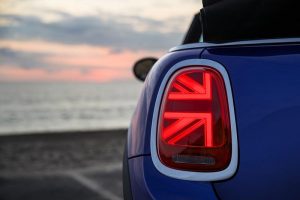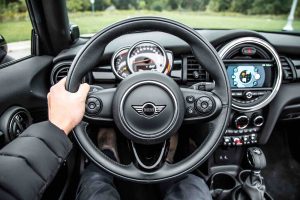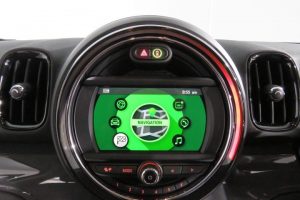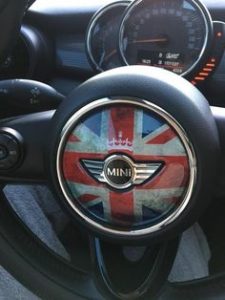When you can’t get a manual transmission in a small sporty car anymore, you know it’s close to The End for manual transmissions.
And possibly sporty small cars, too.
Like the BMW Mini Cooper – which the smallest sporty new car you can buy.
And which you can no longer buy with a manual transmission – chiefly because of pressure from the government to squeeze more MPGs out of new cars. More precisely, to achieve better MPGs on the government’s mandatory minimum MPG test loop. And automatics are better at that because they can be programmed to shift in such a way as to maximize MPGs . . . for testing purposes.
Sigh.
What It Is
The Mini Cooper is the iconic British small car made by German car company BMW. It has lots of British heritage – and German engineering.
There’s good – and bad – to both.
You can get it as a two-door hardtop (with hatchback) or a four-door hardtop (also hatchback’d) with your pick of three or four cylinder engines, the latter in two states of tune (hot and hotter). You can also order up an almost limitless combination of colors and trim pieces, to customize your Cooper and make it uniquely your Cooper.
The one thing you can’t get anymore, however, is a manual transmission. All Minis are now automatic-only.
But you do still get to pick seven or eight speeds.
Prices start at $23,400 for the base trim hardtop coupe with a 1.5 liter three-cylinder engine and seven-speed automatic transmission. The sportier S trim gets a larger, stronger 2.0 liter engine – also paired with the seven-speed automatic. The sportiest John Cooper Works (JCW) trim gets the same 2.0 liter engine – but with more turbo boost and substantially more horsepower – along with an eight-speed automatic transmission.
The four-door comes in base ($24,400) and S ($28,400) trims, with the same engines and transmissions – but a bit more backseat leg and cargo room.
What’s New
The main change for 2020 is the elimination of the option to change gears yourself. 
But there is one consolation for this reduction. This spring, Mini is going to offer an ultra-performance GP package (two-doors only) with 302 horsepower and a top speed approaching 170 MPH.
Oh, behave!
Only 3,000 of these are going to be made, so if you’re interested, get to your local Mini store while they’re still open (and possibly before they close forever).
What’s Good
Still a lot of fun.
A lot of cargo space for the size.
Classic British car cachet – without classic British car wiring.
What’s Not So Good
Less fun without a manual option.
Not enough backseat space for the human-sized.
JCW performance package no longer offered with the four-door Mini.
Under The Hood
Both two and four-door Minis come standard with a BMW-sourced 1.5 liter turbocharged three cylinder engine that makes 134 horsepower – which is not very much horsepower, even for a very small car.
But the horsepower deficit is compensated for by an abundance of torque. The little engine makes 162 ft.-lbs. of twist at just 1,250 RPM, which is enough to get the Mini to 60 in about 7.6 seconds, a very speedy time for a car with not very much horsepower.
If more horsepower – and torque – are wanted, the Mini S has you covered with a larger, 2.0 liter four cylinder engine – also turbocharged. It makes 189 horsepower and 207 ft.-lbs. of torque, enough to drop the car’s time to 60 down to just over 6 seconds.
For the most horsepower – an torque – there’s the pinnacle Mini, the John Cooper Works (JCW)) version. It also has a 2.0 liter turbocharged four cylinder engine but the output is bumped up (via more turbo boost) to 228 hp and 236 ft.-lbs. of torque. Which drops the 0-60 time into the highs fives – which makes the JCW Mini one of the speediest smallest cars on the road.
The base 1.5 liter and 2.0 liter engine in the S are paired with a seven-speed automatic; the JCW’s higher-output version of the 2.0 liter engine is paired with an eight-speed automatic – the extra gear helping the more powerful 2.0 liter engine to achieve mileage that’s photo finish-close to the less powerful 2.0 liter engine’s numbers: 26 city, 34 highway for the 228 hp iteration in the JCW vs. 26 city, 35 highway for the S with just 189.
And both are photo finish-close to the base 1.5 liter Mini’s 28 city, 36 highway.
Which is why the manual is no longer available.
Last year, the S and JCW versions of the Mini with the standard six-speed manual transmission and otherwise identical to the 2020s with the standard automatics rated 23 city, 32 highway, the both of them.
Not photo finish close.
Three MPGs in city driving and 2-3 on the highway may not seem like much – and isn’t, from the standpoint of the driver and especially when you factor in the cost of gas, which is low – and driving styles, which vary. But the difference is huge from the standpoint of Mini – which must “comply” with those government-enforced mandatory MPG minimums, which are currently set at just under 36 MPG.
Interestingly, the 2019 Mini with the 1.5 liter engine and the six-speed manual you used to be able to get rated 28 city, 38 highway – slightly better on the highway than the 2020 with the same engine and the seven-speed automatic.
But that 2 MPG difference on the highway wasn’t enough to offset the 3 MPG difference in the other direction for the S and JCW Minis with the manual – and so the kibosh was put on the manual for all of them.
On The Road
The Mini – either four doors or two – is still a lot of fun to drive even if there’s less for the driver to do, now that the option to shift for yourself is off the table.
Objectively, the seven and eight-speed automatics work better with the turbo-boosted 1.5 and 2.0 liter engines because they multiply the advantages of all that low-down torque – via the automatic’s torque converter, which magnifies an engine’s torque during initial acceleration from a standstill.
Even the 1.5 liter engine will skitter the tires if you floor it from a dead stop – with the traction control off. The 2.0 liter engine can roast them, especially if you load up the torque converter by power-braking the thing before you launch.
But the manual is more intangibly fun. Too bad it’s gone.
What’s still there, however, is the Mini’s ability to maneuver. Driving this car is like playing Frogger – the video game where a digital frog hops from log to lily pad to rock, all the way across the river.
It’s much more fun to do this on the road. Half a standard car’s length in between you and the Clover ahead is enough room for the Mini to make its move. Bye-bye Clover! The Mini makes its happy sounds as you thread the needle.
It is almost as much fun as riding a motorcycle. More fun, when it’s raining. Because you’re dry.
And just as easy to park as a bike. Because it’s about the same length as one. If you need a back-up camera to park this one, you shouldn’t be driving anything.
At The Curb
The Mini’s look – and concept – dates back to the ’60s (and England) but it hasn’t gotten old (even though the car is now built by Germans).
It manages the hat trick of being cute without being feminine. Snarky – without being menacing. Everyone, just about likes the Mini.
Part of the reason for that – other than its makes-you-smile appearance – is its very small footprint. The two-door is only 151.9 inches long, which is about three feet shorter overall than a current mid-sized sedan.
And yet, it has 34 cubic feet of cargo space – about twice as much space as most mid-sized sedans have. Headroom is also more than you’d expect – almost 40 inches for the driver and front seat passenger.
The catch is that neither the two or the four-door Minis have much backseat space. The coupe’s 30.8 inches of legroom limit how many people can ride in the car; or rather, how many people are willing to ride in the car.
If you can handle four doors, you’ll get a more doable 32.3 inches, which is on par with what you’d find in the backseat area of a current model year compact-sized sedan, which will not have 40.7 cubic feet o cargo capacity, as the four-door Mini’s got with its back seats folded down.
All Minis come with amenities – including standard simulated leather in the base trim, a six-speaker stereo and adaptive cruise control. They also come standard with retro-cool features such as ’60s-style toggle controls for the power windows and door locks and a re-imagining of the original ’60s Mini’s huge centrally mounted speedometer, which is now a huge centrally mounted LCD touchscreen.
S and JCW trims get driver-selectable modes – including Let’s Motor! (Mini-speak for sport mode) and Let’s Maximize (Mini-speak for eco mode). Ambient cabin lighting adjusts accordingly.
Mini offers a Signature package – available with any Mini – that decks the car out with a panorama sunroof and seat heaters; you can upgrade to the Premium Signature and get an excellent 12-speaker Harman Kardon ultra-premium audio system.
There are too many individually available options and trim combos to list, which list includes both factory options and dealer-available options that you buy over the counter and add yourself or have the dealer install.
The Rest
Unusually for a modestly priced car aimed at people looking for economy as well as fun, all of the Mini’s available engines require premium unleaded fuel. Which requires some explanation. It doesn’t mean that using regular unleaded will damage the engines; but it does mean you probably won’t get the advertised power or gas mileage out of them.
There’s an irony here. The manual was done away with for the sake of MPGs uber alles. But to achieve the mileage advertised, you have to spend an extra 20 cents or so per gallon for the premium fuel the engines need to achieve that mileage.
The good news is that thanks to Corona Fever, premium gas now costs less than regular unleaded did three weeks ago.
The probable news is the Mini itself is likely to cost a lot less soon, too – as Corona Fever waxes and Mini stores the ones still one – get more an more desperate to sell you a new Mini.
And if you still want that manual Mini, wait a little longer. The mass unemployment-at-government-point created by Corona Fever is going to trigger a tsunami of repos as people stop making payments they no longer have the money to make.
I – when – this Corona Fever ends – it may also mean the end of the government decreeing mandatory MPG minimums. And then we’ll be able to buy sporty small cars with manual transmissions again.
The Bottom Line
Still cute, still fun. But it was always more fun with a clutch.
. . .
Got a question about cars, Libertarian politics – or anything else? Click on the “ask Eric” link and send ’em in!
If you like what you’ve found here please consider supporting EPautos.
We depend on you to keep the wheels turning!
Our donate button is here.
If you prefer not to use PayPal, our mailing address is:
EPautos
721 Hummingbird Lane SE
Copper Hill, VA 24079
PS: Get an EPautos magnet or sticker or coaster in return for a $20 or more one-time donation or a $10 or more monthly recurring donation. (Please be sure to tell us you want a magnet or sticker or coaster – and also, provide an address, so we know where to mail the thing!)
My latest eBook is also available for your favorite price – free! Click here. If that fails, email me at [email protected] and I will send you a copy directly!












Hi Eric,
Thanks for the Mini Cooper review. Here are a few observations.
I Really Like the package. Small enough to be peppy, nimble and easy to park. Boxy design makes it practical too. But due to Mini’s lingering rep for unreliability and poor construction, I’d never buy one.
The “edgy” body design elements are understandable, and work OK. But why oh WHY do they have to wrap it in so many garish, conspicuous, paint stripes? Just because it’s the Cooper version doesn’t mean they have to make it ugly.
Just like all small cars, crash survivability is sub optimal. That’s a real issue if one drives on roads where T-bones, or crashes with giant trucks are very possible. If one drives in tight congested cities, or small, older communities with low speed roads, and few semis, the crash/crush risk is minimized.
To conclude…..if the Mini Copper “were” reliable, and offered a “paint stripe delete” option, I’d want one.
I still, with a bit of nostalgic fondness, recall breaking my brain in a vain attempt to get my ’68 Triumph Tiger to fire over. Who was this “Joe Lucas – Prince of Darkness” and what manner of madman was he, to design and install a 6 volt positive ground wiring array?
Bollocks.
I tore it all out and installed a Morris Magneto.
Hi AF,
Great memories! I’ve had some fun working on a Morris Minor – which is similar to the Mini. Even though these cars have their quirks, they make up for them with personality!
“When you can’t get a manual transmission in a small sporty car anymore, you know it’s close to The End for manual transmissions.”
Seems the bankrupt auto industry intends to make manual shifts go the way of hand-cranked engines in the early 20th century (though some marques retained a vestigial hole in the grille into the 1950s … a kind of automotive belly button).
When the Mazda MX5 Miata deletes the manual trans, we’ll know it’s really all over. Fortunately a legacy fleet of 30 years worth of manual-trans vehicles remains, many with low mileage, as their absence of back seats or cargo space consigns them to recreational use only.
A few original Mini Coopers with their 10-inch lawnmower wheels turn up on CL now and then. But they are so few in number as to command a hefty rarity premium.
What would a Peoples Car for the impoverished 2020s look like, if Uncle permitted it to be built?
As attractive as these are, I can’t stop thinking about the accident I saw several years ago where a mini was sandwiched between a big pickup and 18 wheeler. I looked an accordion that had been completely squeezed and was fatal. As much as I like little cars, the safety space just isn’t there, and with people as distracted driving worse than ever, I’ll stick to a bigger small sporty car. YMMV.
Hi Saxon,
Sure – but motorcycles are even worse in that respect! I still ride. But with due paranoia.
And, in my little 1970 Datsun 510, I successfully avoided at least two T-bones by being alert and having a highly maneuverable car. I literally drove out of the trajectory of the oblivious idiots trying to kill me. Caveat: I did not have the stock bicycle wheels and skinny tires.
Eric and James,
I agree that defensive driving and situational awareness are key to survival on the roads today. I also used to ride bikes on a near daily basis. And I wholeheartedly embrace “caveat emptor” for risk management on the road. Indeed, it’s not paranoia, because they really are OUT to get you. I was never worried about the bullet that had my name on it, but the other bazillion or so that were flying around that had, and have, “to whom it may concern” written on them. The most dangerous activity 99% of us will do in the next day or so will be to climb in or on an ICE machine and zip around on daily business. With proper training, diligence, and SA, we come home fine and think nothing more about it. But, all it takes is one moment or two of inattention and boom, it’s game over, lights out. Despite all my training and 40+ years of operating motor vehicle s, I still am amazed that I have not suffered worse accidents and injuries, and I’ve only had a handful. Keep up the great work, your voice is like a beacon in the wilderness. Bravo Zulu!!
Amen, Saxon – and, thanks!
I’ve been riding (and driving) “paranoid” for decades, which is probably why I am still riding and driving! I assume every other vehicle in my orbit is out to get me and am always thinking about what I’ll do if…. that has saved my buttocks (and the rest of me) on several occasions. Keep the shiny side up!
“Classic British car cachet – without classic British car wiring.”
Now Eric, how many times do I have to say, Lord Lucas, the Lord of Darkness is defunct, pining for the Fiords, etc.! It is no longer true that a Mini will have a headlamp switch with three positions, Dim, Flicker, and OFF! It is no longer required to keep a jar of Lucas Parts Approved Magic Smoke on the shelf, for when (not if) the fault happens and all the smoke comes out of your Lucas wiring! 🙂
Sadly, nowadays, that British wiring is more likely German, and prone to other, more dastardly faults than the simple, annoying, four-letter-aria-inducing ones Lucas wiring was.